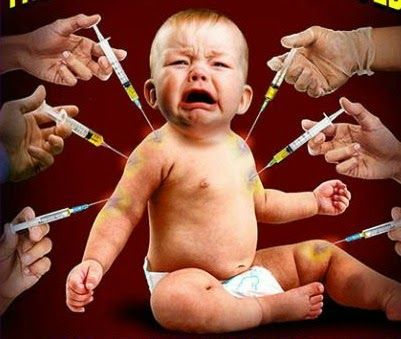Not only does the following study demonstrate the painful results of babies getting jabs, but is said to be the first time that recordings of brain activity have been conducted in response to real-life needle pain in infants.
It would seem like a study of this nature would have been performed eons ago, and on that note it is morbid that such a study is needed at all. Perhaps it is a growing distaste for vaccines that prompts a study like this with the aim of supporting future painless vaccines or some type of pain relief at the time of inoculation.
The pro-vaccine authors want the public and the health care providers to know that vaccines are the most common cause of procedural pain in children. That the pain is real and can lead to lifelong fear of needles, trauma and distrust.
Comment: Are the authors afraid that the pain of the jab would register so strongly that no one would ever want to get another vaccine again? This seems to be a moot point. Babies and children don't willingly submit to vaccines. They are forced into having them by the very people they trust and who, apparently, find their perception of pain irrelevant.
As it happens, researchers from University College London, with their work published in the International Association for the Study of Pain's recent issue of PAIN®, want to focus on future pain-relieving measures.
"We have shown that inoculation evokes, from the time of the first needle contact, a clearly defined EEG response in infants up to at least one year of age," they say.
From the study press-release (emphasis added):
Brain Activity in Response to Shots in Infants...Then, vaguely, they suggest that behavioral pain perceived (maxing 8 on a 10-point scale) doesn't necessarily match the EEG, which does show the brain trying to process the pain. Does that mean the actual pain was less or worse than the behavioral signs? Not clear, but the point was to demonstrate the reality of vaccine pain despite behavior (although most children respond in the obvious way to vaccination).
The researchers performed elecroencephalography (EEG) in 15 healthy babies receiving routine vaccinations. A noninvasive and painless procedure, EEG is done to measure electrical activity in the brain, using electrodes placed in specific locations on the scalp. Twelve infants were tested during vaccinations at age one to two months, and five at age 12 months.
Dr Verriotis and colleagues compared the EEG findings with behavioral pain responses: facial expression, crying, and movements. Such behavioral responses are the standard method for assessing pain in preverbal infants. The researchers filmed the procedures to identify the precise timing of EEG responses to vaccination pain.
The EEG recordings showed two clear waveforms, or "spikes," which appeared within milliseconds after the first contact of the needle with the infant's skin. Although the waveforms appeared in both age groups, they were significantly larger in one- to two-month-old infants than in one-year-olds.
In three infants studied at both ages, the EEG responses--particularly for the first waveform--appeared clearer and larger at age 12 months. The EEG patterns were also more reproducible in older infants. The researchers suggest that these age-related differences might reflect developmental changes in the brain during the first year of life: an increased number of neurons (nerve cells), a larger proportion of neurons being activated, or better synchronization of firing activity.
The fact that the wave forms were larger in young infants versus one-year-olds despite the same obvious behavior from both says something about development. Is it really a great idea to experience that type of high-threshold trauma so early in life?
What also stands out when viewing this study is: society punishes parents who spank their children - but what are the implications of an authority figure taking her infant to another authority figure and handing them over for a painful injection, and again later on with implied promises of "you'll get better" or this is "for your own good (and society's)?" Where it's possible that neither party fully comprehends not only the ingredients' effects in the bloodstream, but the long-term biological impact.
Besides, talk about trust issues....




by Aurthur Janov in the mid-'70s. Here's an Amazon [Link] .
And a good review of the book:
"Despite the age of this book the information it contains is still very relevant. Finally a book on how to raise children from the child's point of view.This book explains how the needs of the child are paramount and must be adhered to in order to avoid psychological trauma to the child which results in behavioral, as well as physical problems, later in life. The book explains how parents are often so cut off from their own feelings that they overlook the needs of their children despite the best of intentions.Includes background information on how traumatic events in childbirth and throughout childhood are stored neurologically to produce the psychobiological condition of neurosis. Simple to read yet very scientific.However, even though the book contains background information on the formation of neurosis, I would highly recommend reading one of his other books in addition to this one in order to get a better understanding of why it is so important to raise children from the child's perspective."
And yes ==> of course <== children feel things. Jesus Christ, how STUPID are most 'addleds' anyway . . .